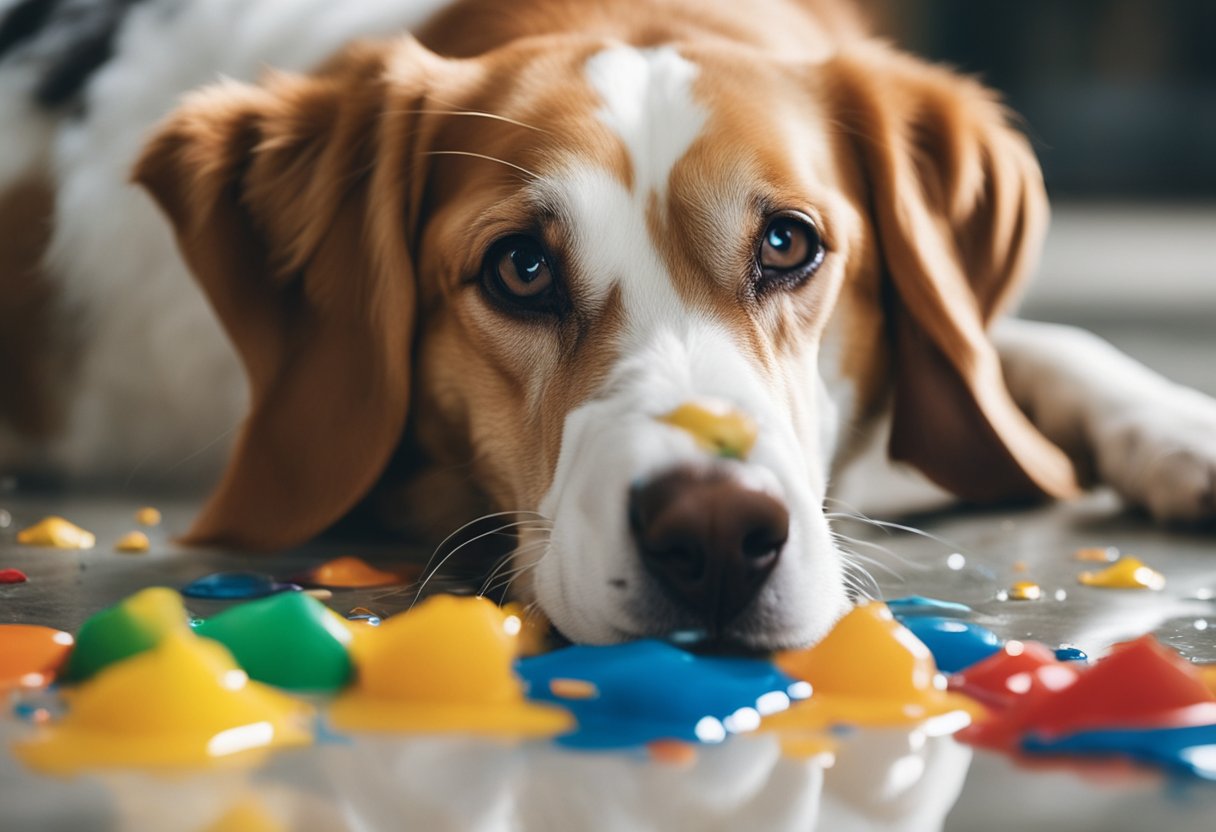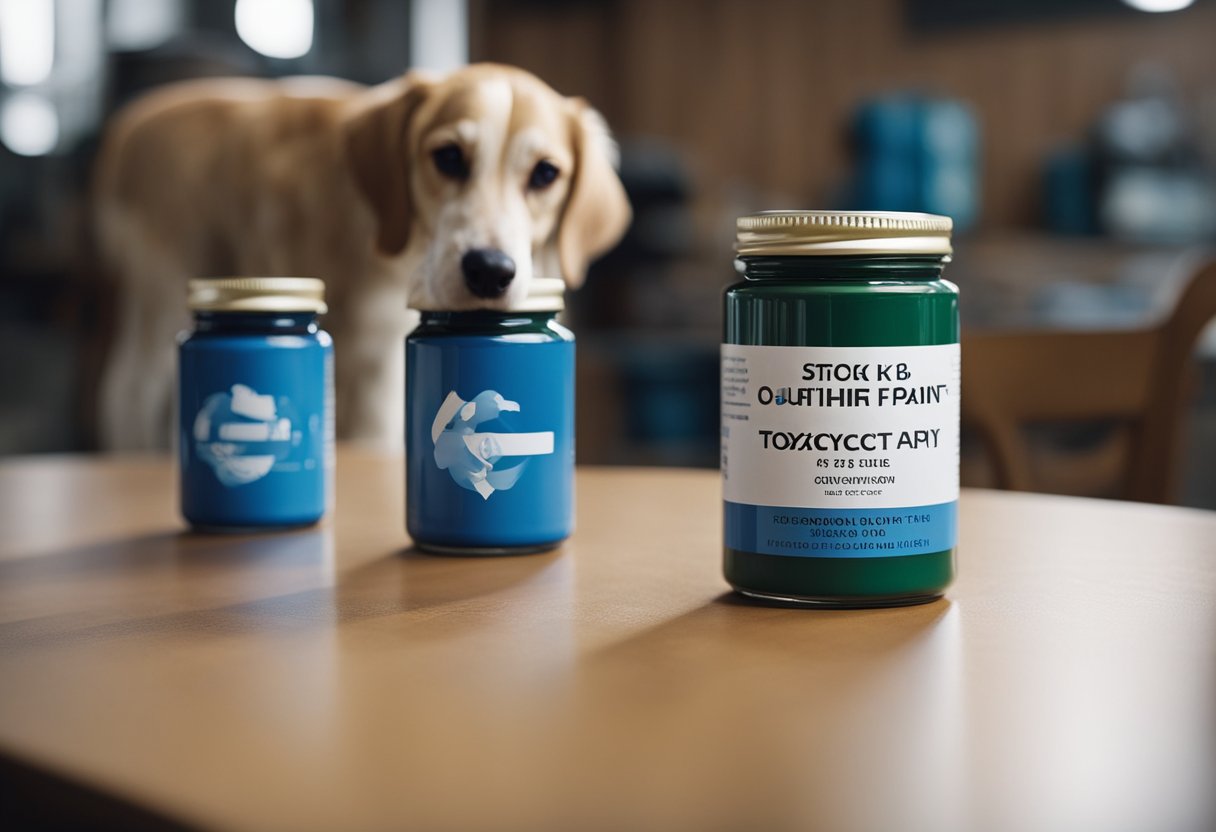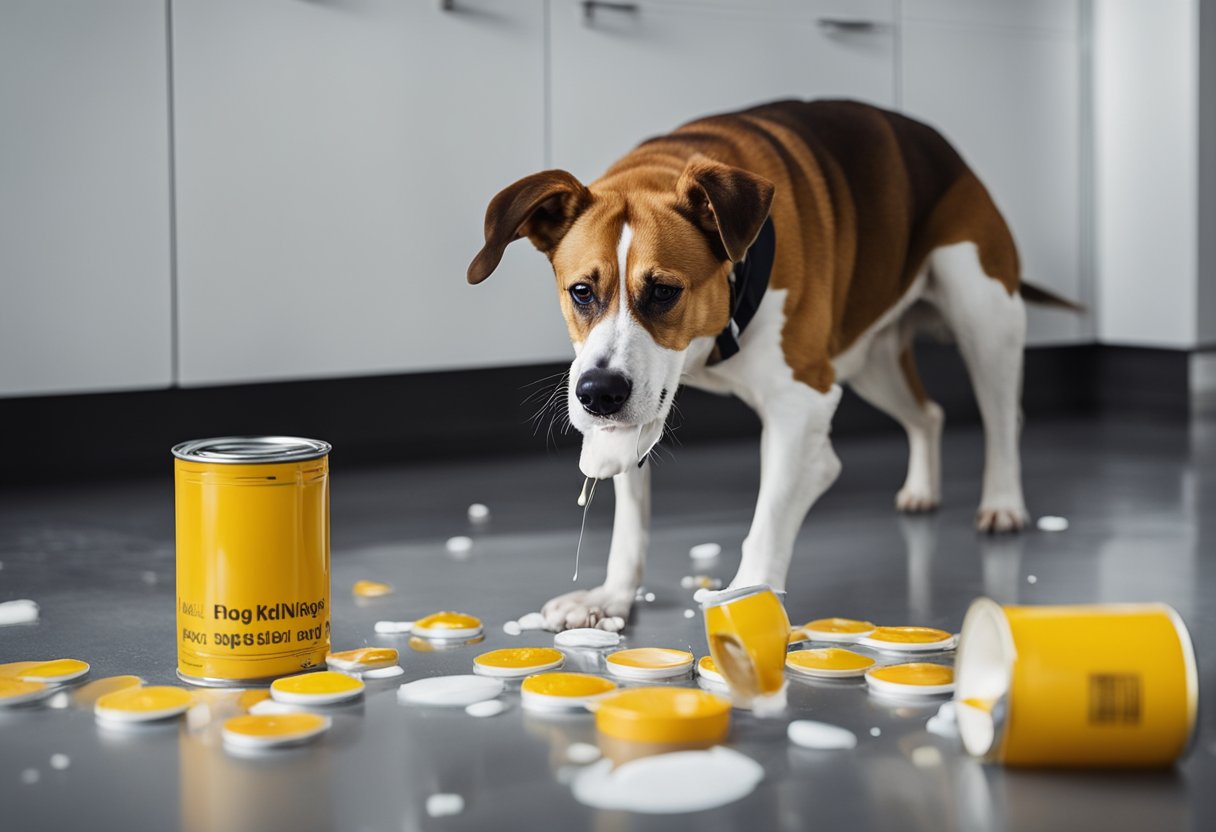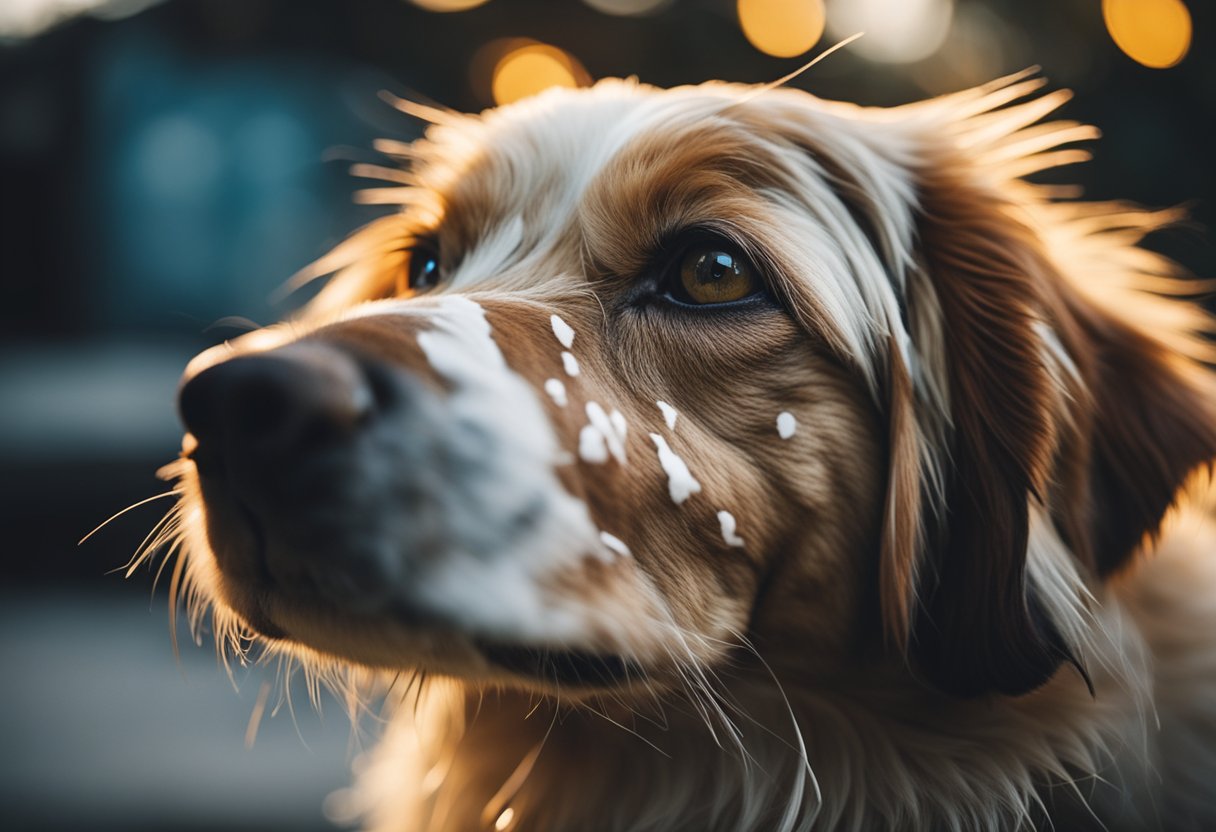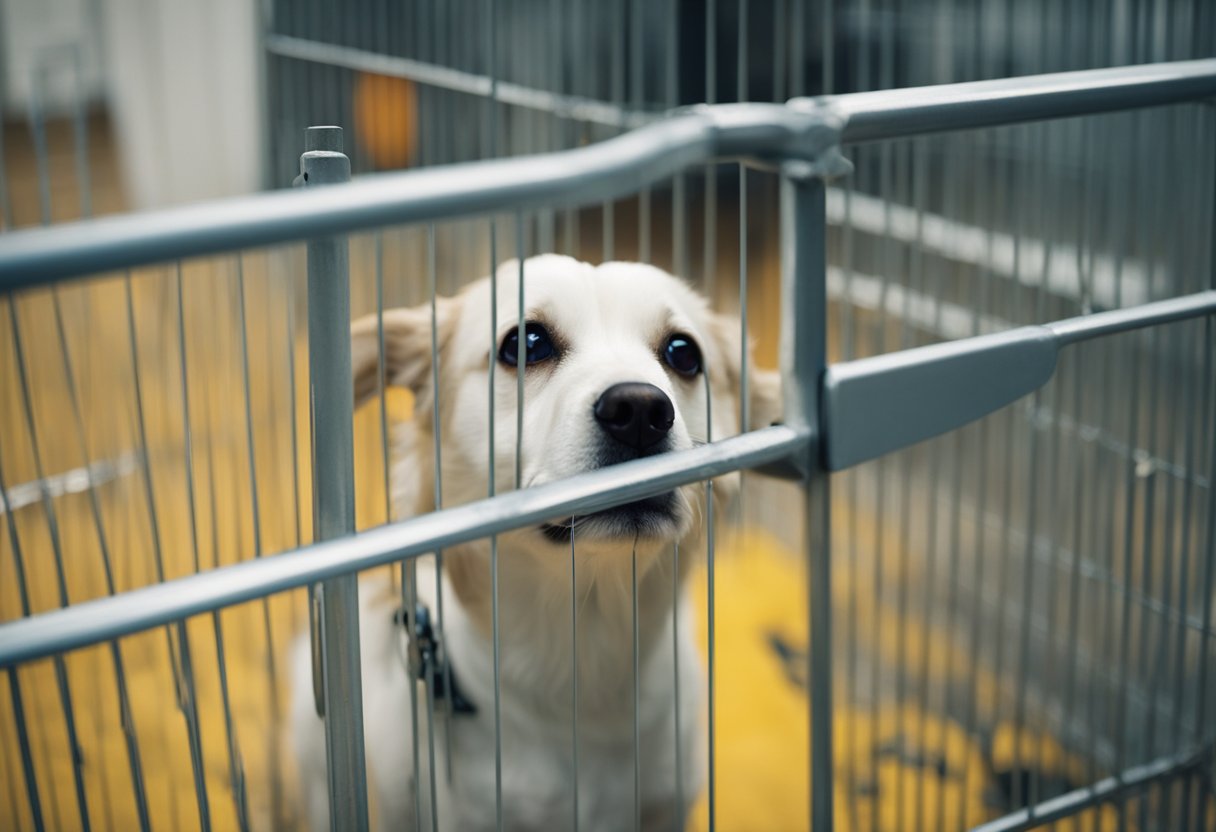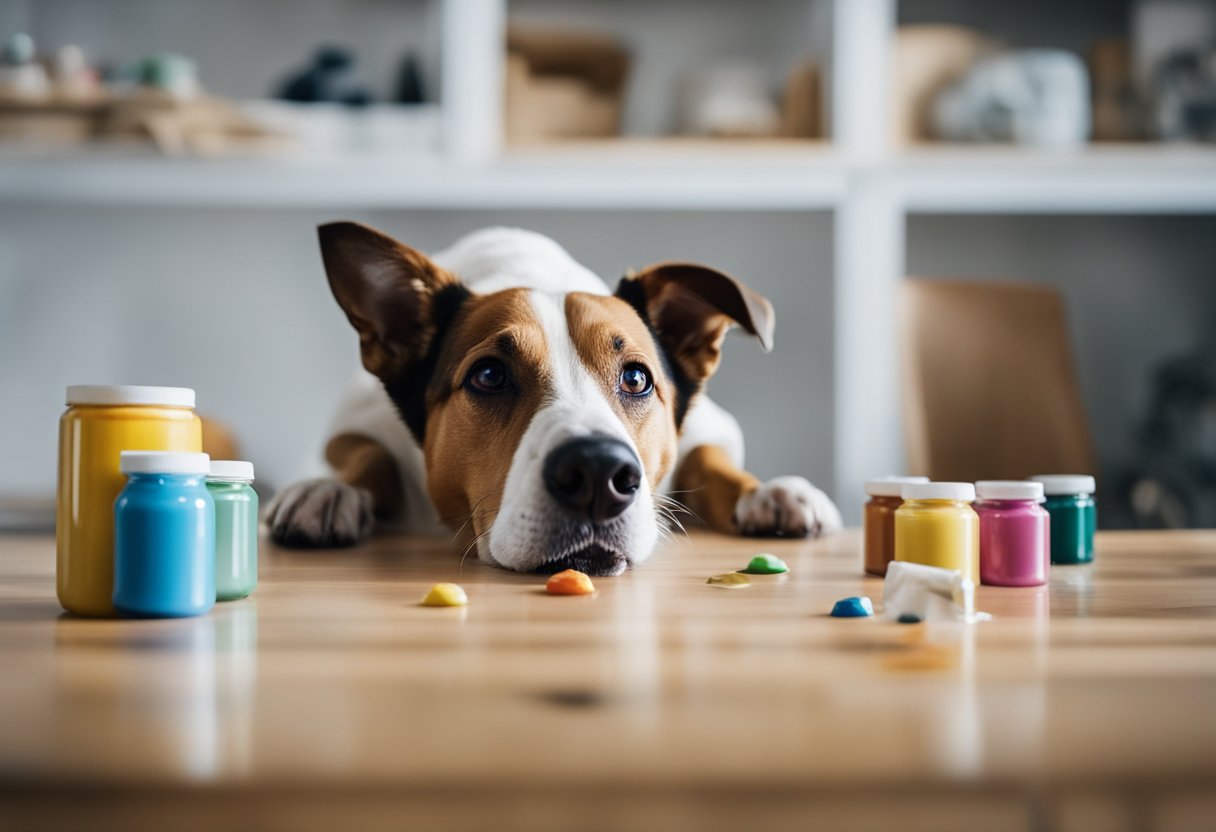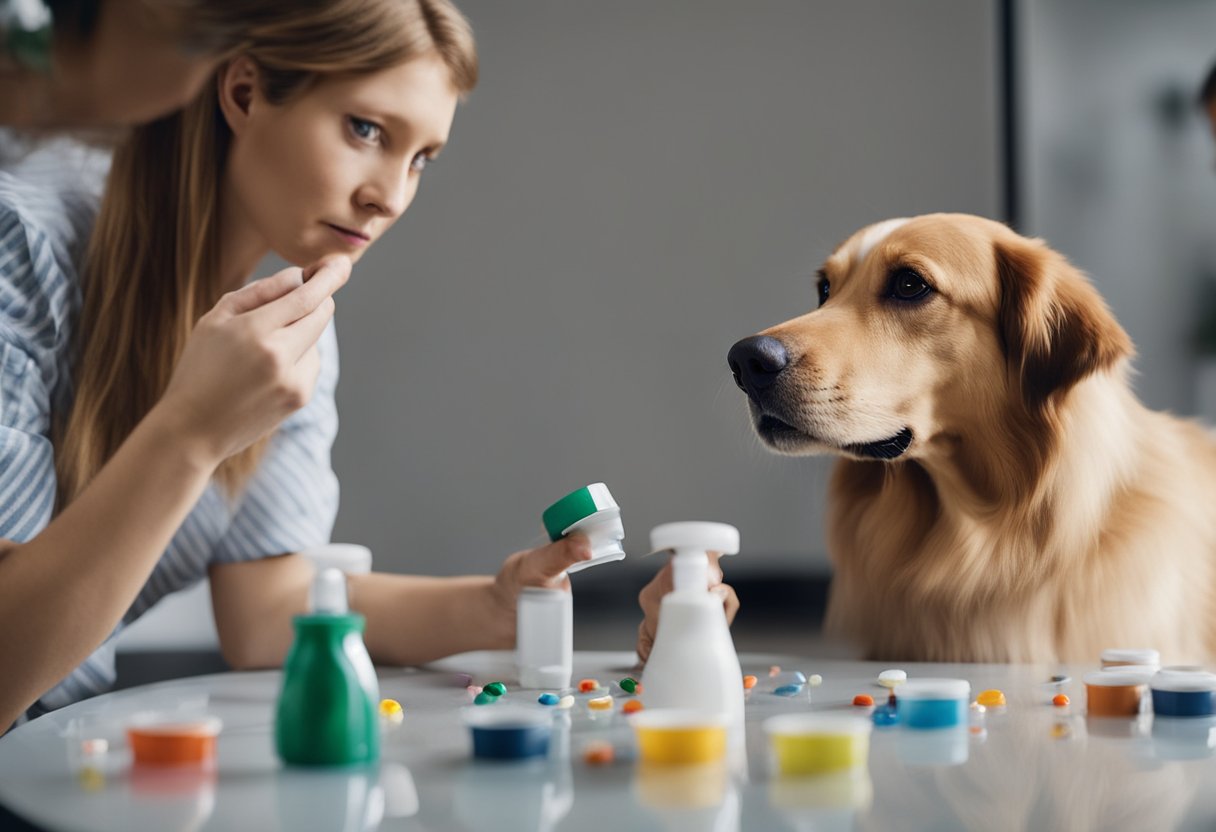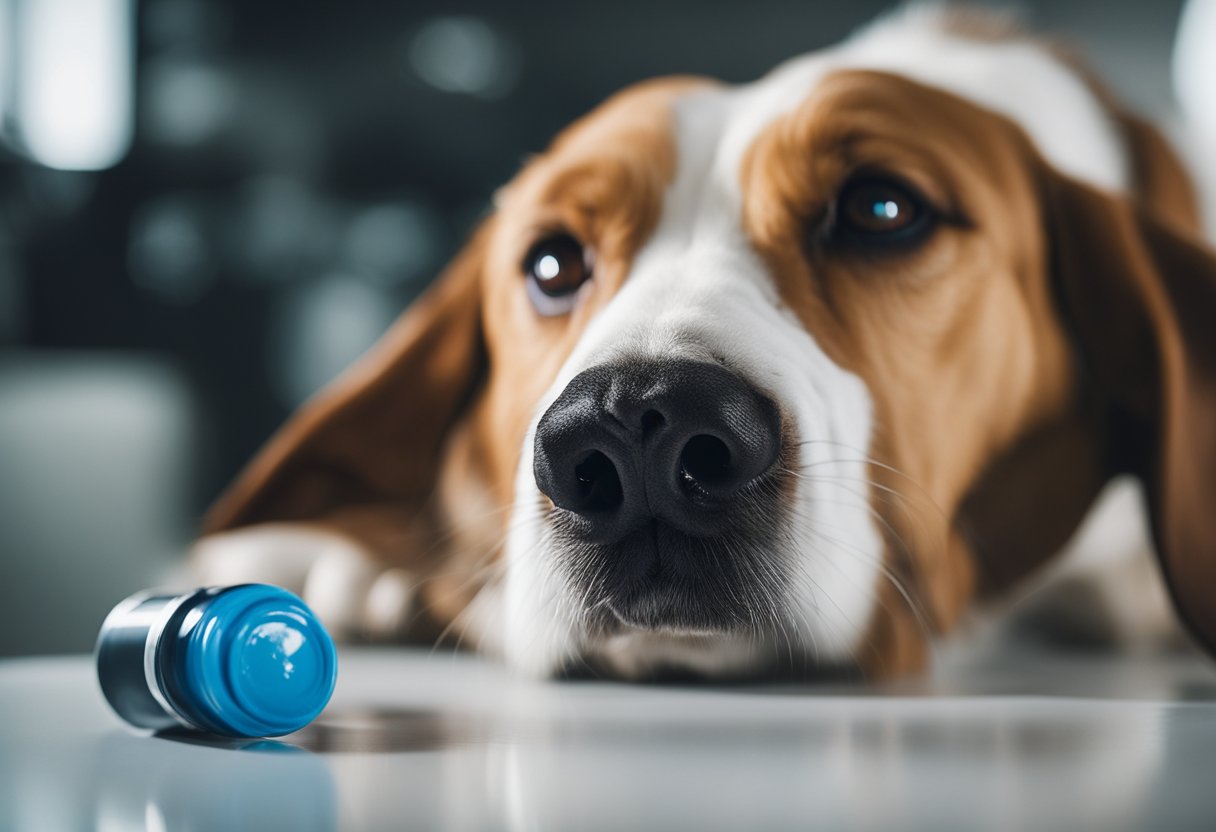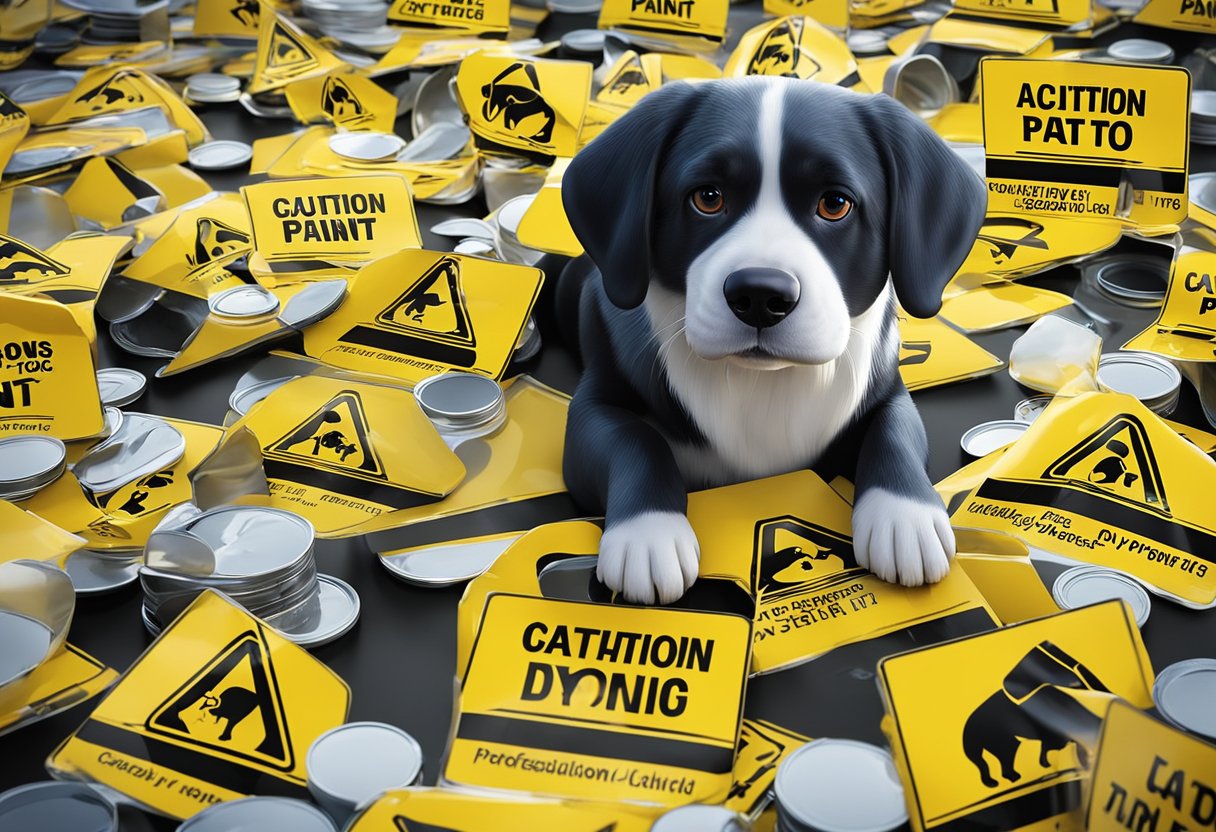As a dog owner, it’s important to be aware of the potential hazards surrounding acrylic paint if your furry friend happens to come into contact with it. Acrylic paint is a popular medium used by artists, but it can be dangerous for pets if ingested or if it comes into contact with their skin or fur. In this article, I will discuss the toxicity of acrylic paint for dogs and what to do if your pet has been exposed to it.
Acrylic paint is water-based and contains a mixture of pigment particles and a polymer emulsion. Although it is not highly toxic to dogs, it can still cause adverse health effects if ingested or inhaled in large amounts. The risk of toxicity depends on the type of acrylic paint, the amount ingested, and the size and weight of your dog.
Key Takeaways
- Acrylic paint can be dangerous for dogs if ingested or if it comes into contact with their skin or fur.
- The risk of toxicity depends on the type of acrylic paint, the amount ingested, and the size and weight of your dog.
- If your dog has been exposed to acrylic paint, it’s important to seek veterinary help immediately.
Understanding Acrylic Paints
As an artist and a pet owner, I understand the importance of knowing whether acrylic paint is toxic to dogs. Acrylic paints are a popular choice for artists because they are water-based, easy to use, and dry quickly. They are made up of pigments, resins, and water, and are often used as a substitute for oil paints.
Unlike oil paints, acrylic paints do not contain oils or varnish, which makes them less toxic. They are also less likely to cause respiratory problems, making them a safer option for artists who work in small spaces. The water-based nature of acrylic paints also means that they are easier to clean up and do not require the use of solvents.
Acrylic paints are made up of different pigments and ingredients, which can affect their toxicity. While most acrylic paints are non-toxic, some contain ingredients that can be harmful if ingested in large amounts. It is important to read the label of the paint you are using to ensure that it is non-toxic and safe for your pet.
In conclusion, acrylic paints are generally safe for dogs as they are water-based and contain less toxic ingredients than oil paints. However, it is important to use non-toxic acrylic paints and to keep them out of reach of pets. If your dog ingests acrylic paint, it is important to seek veterinary treatment immediately.
Acrylic Paint and Its Toxicity
Acrylic paint is a popular medium used by artists and crafters for various projects. As a dog owner, it’s important to know whether acrylic paint is toxic to dogs.
Acrylic paints are generally considered non-toxic, but some pigments may contain harmful chemicals such as cadmium or lead. Cadmium is a heavy metal that can cause kidney damage, while lead can lead to anemia and neurological problems. It’s important to check the label or product information to identify the pigments used in the paint.
In addition to pigments, some acrylic paints may contain other harmful chemicals such as glycols, including ethylene glycol, which can be toxic to dogs if ingested. These chemicals can cause symptoms such as vomiting, diarrhea, and even kidney failure.
It’s important to keep your dog away from wet paint and to ensure that any painted objects are completely dry before allowing your dog to come into contact with them. If your dog does come into contact with wet paint, wash the affected area with soap and water immediately. If your dog ingests any paint, seek veterinary attention immediately.
In conclusion, while acrylic paint is generally considered non-toxic, it’s important to be aware of the potential risks associated with certain pigments and chemicals. By taking the necessary precautions and keeping your dog away from wet paint, you can help ensure your pet’s safety.
Effects of Ingesting Acrylic Paint
https://www.youtube.com/watch?v=PX7DR0rRLYo&embed=true
As a dog owner, it’s important to know the effects of ingesting acrylic paint. While some sources claim that acrylic paint is not toxic to dogs, it’s important to note that ingesting large amounts of it can be harmful to your pet’s health.
If your dog ingests acrylic paint, they may experience symptoms such as vomiting, diarrhea, difficulty breathing, lethargy, nausea, gastrointestinal upset, seizures, organ damage, upset stomach, drooling, weakness, tremors, and even kidney failure in severe cases.
It’s important to note that the severity of symptoms depends on the amount of paint ingested and the size of your dog. Small dogs are more susceptible to the harmful effects of acrylic paint than larger dogs.
If you suspect that your dog has ingested acrylic paint, it’s important to contact your veterinarian immediately. They may recommend inducing vomiting or administering activated charcoal to prevent further absorption of the paint.
In conclusion, while acrylic paint may not be toxic to dogs in small amounts, it’s important to keep it out of reach and monitor your pet closely if they come into contact with it. If you suspect that your dog has ingested acrylic paint, seek veterinary care immediately to prevent any potential harm to your pet’s health.
Effects on Skin and Fur
As a dog owner, it is essential to keep your furry friend safe from toxic substances. Acrylic paint can be harmful to your dog’s skin and fur if it comes in contact with them. The chemicals in acrylic paint can cause skin irritation, redness, and itching. If your dog has sensitive skin, it is more prone to irritation from acrylic paint.
When acrylic paint gets on your dog’s fur, it can cause matting and clumping. The paint can also dry out your dog’s fur, making it brittle and prone to breakage. If your dog ingests the acrylic paint by licking it off its paws or fur, it can cause digestive issues such as vomiting and diarrhea.
To prevent skin irritation and fur damage, it is essential to keep your dog away from acrylic paint. If your dog accidentally gets paint on its paws or fur, wash the affected area with mild soap and water immediately. You can also use pet-friendly wipes to clean your dog’s paws and fur.
In conclusion, acrylic paint can be harmful to your dog’s skin and fur. It is essential to keep your dog away from acrylic paint and clean any accidental exposure immediately. If your dog shows any signs of skin irritation or digestive issues after exposure to acrylic paint, contact your veterinarian immediately.
Safety Measures for Pets Around Paint
As a pet owner and lover, I understand the importance of ensuring the safety of our furry friends. When it comes to painting, it is crucial to take certain safety measures to ensure that our pets are not exposed to harmful substances. Here are some safety tips that I follow to keep my pets safe around paint:
-
Keep paint out of reach: I always make sure to keep paint and painting materials out of my pet’s reach. This includes storing them in a secure cabinet or on a high shelf. This helps prevent my pets from accidentally ingesting or coming into contact with the paint.
-
Monitor pets around paint: I never leave my pets unattended around paint. If I am painting, I always keep a close eye on my pets to ensure that they do not come into contact with the paint.
-
Clean up spills immediately: Accidents happen, and spills are inevitable. If I spill any paint, I always clean it up immediately to prevent my pets from accidentally ingesting it.
-
Use non-toxic paint: When choosing paint, I always make sure to use non-toxic paint that is safe for pets. Water-based acrylic paint is generally considered safe for pets if ingested in small amounts. However, it is still important to keep it out of reach and monitor pets around it.
-
Clean up with soap and water: After painting, I always clean up with soap and water to ensure that there is no residue left behind that my pets could come into contact with.
By following these safety measures, I can ensure that my pets are safe around paint. It is always better to be safe than sorry, and taking these precautions can prevent accidents and keep our furry friends happy and healthy.
Alternatives to Acrylic Paints
As I mentioned earlier, acrylic paint can be harmful to dogs if ingested in large amounts. Therefore, it is important to consider using alternatives to acrylic paints when painting your dog’s paws or other projects involving your furry friend.
One great alternative to acrylic paint is watercolors. Watercolors are non-toxic and safe for dogs, making them a great choice for pet owners who want to keep their pets safe while still enjoying the fun of painting. Additionally, watercolors are easy to clean up, making them a convenient choice for those who want to keep their dog’s paws tidy.
Another alternative to acrylic paints is tempera paint. Tempera paint is also non-toxic and safe for dogs, making it a great choice for pet owners who want to keep their pets safe. Additionally, tempera paint is washable, making it easy to clean up after painting.
For those who prefer to use latex paints, it is important to choose a brand that is labeled as non-toxic and safe for pets. Some latex paints can contain harmful chemicals that can be dangerous to dogs if ingested, so it is important to read labels carefully and choose a safe brand.
Oil-based paints, including oil-based paint and oil paint, should be avoided when painting anything involving your dog. These paints contain harmful chemicals that can be toxic to dogs if ingested, and can also be difficult to clean up.
In summary, there are several alternatives to acrylic paints that are safe for dogs, including watercolors and tempera paint. When using latex paints, it is important to choose a non-toxic and safe brand. Oil-based paints should be avoided when painting anything involving your dog.
When to Seek Veterinary Help
As a responsible pet owner, it is important to know when to seek veterinary help if your dog ingests acrylic paint. If your dog has ingested a significant amount of paint or paint containing toxic substances, it is important to seek immediate veterinary attention.
The symptoms of acrylic paint poisoning in dogs can vary depending on the amount ingested and the specific chemicals in the paint. Some common symptoms include vomiting, diarrhea, loss of appetite, lethargy, and seizures. If you notice any of these symptoms in your dog after it has ingested acrylic paint, it is important to seek veterinary help immediately.
It is also important to note that some dogs may be allergic to certain chemicals found in acrylic paint. If your dog has an allergic reaction to the paint, it may experience symptoms such as swelling, itching, and hives. If you notice any of these symptoms in your dog after it has come into contact with acrylic paint, it is important to seek veterinary attention.
If you suspect that your dog has ingested acrylic paint, do not attempt to induce vomiting or administer any medications without first consulting with a veterinarian. The Pet Poison Helpline is a 24/7 animal poison control center that can provide guidance and treatment recommendations. You can contact them at 1-800-213-6680.
In summary, if your dog has ingested acrylic paint or is experiencing any health problems or allergic reactions after coming into contact with it, it is important to seek veterinary help immediately.
Conclusion
In conclusion, acrylic paint can be toxic to dogs if ingested in large amounts. While non-toxic acrylic paint is generally safe for dogs, it is still not recommended to allow them to ingest or chew on it. It is important to keep all paint and art supplies out of reach of pets to prevent accidental ingestion.
If your dog does consume a significant amount of paint or paint containing toxic substances, the following symptoms might appear: vomiting, diarrhea, loss of appetite, lethargy, and seizures. If you suspect your dog has ingested toxic paint, it is important to contact your veterinarian immediately.
It is always a good idea to consult with your veterinarian before introducing any new art supplies or materials to your dog. Additionally, it is important to supervise your dog while they are around art supplies to ensure their safety.
Overall, while acrylic paint can be a fun and creative outlet for pet owners, it is important to prioritize the safety and well-being of our furry friends.
Frequently Asked Questions
Can dogs be harmed by acrylic paint?
Yes, dogs can be harmed by acrylic paint. Acrylic paint contains chemicals that can be toxic to dogs if ingested or inhaled. It is important to keep your dog away from wet paint and ensure proper ventilation when using paint in the house.
What are the risks of acrylic paint ingestion for dogs?
The risks of acrylic paint ingestion for dogs include gastrointestinal upset, vomiting, diarrhea, loss of appetite, lethargy, seizures, and even death in severe cases. The severity of the symptoms depends on the amount of paint ingested and the size of the dog.
What are the symptoms of acrylic paint poisoning in dogs?
The symptoms of acrylic paint poisoning in dogs include gastrointestinal upset, vomiting, diarrhea, loss of appetite, lethargy, seizures, and even death in severe cases. If you suspect that your dog has ingested acrylic paint, it is important to seek veterinary care immediately.
What should I do if my dog ingests acrylic paint?
If your dog ingests acrylic paint, you should seek veterinary care immediately. Your veterinarian may induce vomiting or administer activated charcoal to help absorb the toxins. In severe cases, hospitalization may be necessary.
What are some dog-safe alternatives to acrylic paint?
There are several dog-safe alternatives to acrylic paint, including vegetable-based dyes, natural food coloring, and beet juice. These alternatives are non-toxic and safe for dogs to ingest.
Are there any acrylic paint brands that are safe for dogs?
There are no acrylic paint brands that are specifically designed for dogs. However, there are some acrylic paint brands that are non-toxic and safe for use around pets, such as Liquitex BASICS Acrylic Paint and Apple Barrel Acrylic Paint. It is important to read the label and check for any warnings before using any paint around your pets.

Hi, I’m Sal Muller of Tooltrip.com. My DIY experience led me to understand essential power tools for home projects. Tooltrip.com guides enthusiasts and professionals in choosing right tools for any job. I provide concise top tool reviews for easier, efficient DIY.

